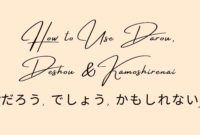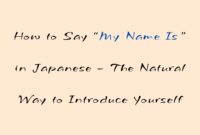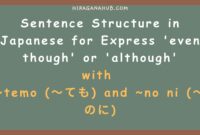How to Use the Particle “de” to Explain Places of Activities in
Japanese

Learning Japanese can be an enjoyable experience, especially when you
understand the fundamental grammar structures. One of the commonly used
elements in everyday conversations is the particle “で” (de).
This article will explain how to use this particle to describe the location
where an activity takes place, with a friendly and easy-to-follow approach.
What Is the Particle “で”?
The particle “で” in Japanese is used to indicate the place
where an activity occurs. Its function is similar to “at” or “in” in English
but is specifically tied to actions or events, not for expressing existence.
Basic Sentence Pattern
The sentence pattern we’ll use is as follows:
Noun 1 + は (wa) + Place + で (de) + Noun 3 + を (o) +
Verb
Explanation:
-
Noun 1: The subject of the sentence, referring to the
person or thing performing the action. - は (wa): A topic marker.
- Noun 2 (place): The location where the activity happens.
- で (de): A particle indicating the place of the action.
- Noun 3: The object involved in the activity.
- を (o): A particle marking the direct object.
- Verb: The action or activity being performed.
Example Sentences
Here are some simple sentences using this pattern:
-
はは は スーパー で にく を かいました
- Romaji: Haha wa suupaa de niku o kaimashita.
- Translation: My mother bought meat at the supermarket.
-
やまだ さん は レストラン で ばんごはん を たべました
- Romaji: Yamada-san wa resutoran de bangohan o tabemashita.
- Translation: Mr. Yamada had dinner at a restaurant.
-
こうえん で サッカー を します
- Romaji: Kouen de sakkaa o shimasu.
- Translation: (We) play soccer in the park.
How to Remember and Practice
-
Apply it to daily activities: When you visit a place, try
creating simple sentences using this pattern. -
Practice writing: Write short daily notes in Japanese with
this structure. -
Swap locations and activities: Vary the places and actions
to expand your vocabulary.
Additional Practice
Here are some more examples for practice:
-
ちち は いま リビング で しんぶん を よんでいます
- Romaji: Chichi wa ima ribingu de shinbun o yondeimasu.
- Translation: My father is reading a newspaper in the living room.
-
こどもたち は へや で ゲーム を しています
- Romaji: Kodomo-tachi wa heya de geemu o shiteimasu.
- Translation: The children are playing games in their room.
-
わたしたち は としょかん で べんきょう します
- Romaji: Watashitachi wa toshokan de benkyou shimasu.
- Translation: We study at the library.
Tips for Using the Particle “で”
- Focus on actions that take place at specific locations.
-
Avoid mixing “で” with other particles like “に,” which serve different
functions. -
Practice this structure with a friend or teacher to gain confidence in
speaking.
Conclusion
The particle “で” is an essential part of Japanese grammar
for describing the location of activities. By mastering the pattern
Noun 1 + は + Noun 2 + で + Noun 3 + を + Verb, you can
easily describe various everyday activities.
We hope this article helps you better understand Japanese grammar! Don’t
hesitate to create your own sentences and keep practicing to improve your
fluency. 😊


